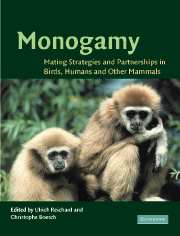Book contents
- Frontmatter
- Contents
- List of contributors
- Acknowledgements
- Introduction
- PART I Evolution of social monogamy
- PART II Reproductive strategies of socially monogamous males and females
- CHAPTER 6 Social functions of copulation in the socially monogamous razorbill (Alca torda)
- CHAPTER 7 Social and reproductive monogamy in rodents: the case of the Malagasy giant jumping rat (Hypogeomys antimena)
- CHAPTER 8 Social polyandry and promiscuous mating in a primate-like carnivore: the kinkajou (Potos flavus)
- CHAPTER 9 Monogamy correlates, socioecological factors, and mating systems in beavers
- CHAPTER 10 Social monogamy and social polygyny in a solitary ungulate, the Japanese serow (Capricornis crispus)
- PART III Reproductive strategies of human and non-human primates
- Index
CHAPTER 6 - Social functions of copulation in the socially monogamous razorbill (Alca torda)
Published online by Cambridge University Press: 05 July 2014
- Frontmatter
- Contents
- List of contributors
- Acknowledgements
- Introduction
- PART I Evolution of social monogamy
- PART II Reproductive strategies of socially monogamous males and females
- CHAPTER 6 Social functions of copulation in the socially monogamous razorbill (Alca torda)
- CHAPTER 7 Social and reproductive monogamy in rodents: the case of the Malagasy giant jumping rat (Hypogeomys antimena)
- CHAPTER 8 Social polyandry and promiscuous mating in a primate-like carnivore: the kinkajou (Potos flavus)
- CHAPTER 9 Monogamy correlates, socioecological factors, and mating systems in beavers
- CHAPTER 10 Social monogamy and social polygyny in a solitary ungulate, the Japanese serow (Capricornis crispus)
- PART III Reproductive strategies of human and non-human primates
- Index
Summary
INTRODUCTION
The fundamental purpose of copulation is sperm transfer. Additionally, however, animals in a wide range of taxa copulate outside the breeding period (reviewed in Bagemihl, 1999), suggesting that copulation is used for multiple purposes. In birds, there have long been reports of pairs copulating outside the female fertile period (Birkhead & Møller, 1992), and a social role for such behaviour, such as the appraisal and acquisition of mates, has been proposed (Colwell & Oring, 1989; Tortosa & Redondo, 1992; Heg et al., 1994). Because copulation requires physical contact it has been viewed as a form of tactile communication (Dewsbury, 1988). In monogamous white storks (Ciconia ciconia), which copulate at high rates but rarely perform extra-pair copulations (EPCs), it has been suggested that females use male copulation performance to appraise the balance, size, and body condition of prospective mates (Tortosa & Redondo, 1992). This hypothesis rests on the Prediction that copulation rate or other aspects of its performance by either sex reflects individual quality. Supporting this prediction is the finding in tree sparrows (Passer montanus) that within-pair copulation frequency covaried with female reproductive performance (Heeb, 2001). Another hypothesis is that copulation is used as a display by males or pairs to signal their possession of the territory (Strahl, 1988; Negro & Grande, 2001).
In monogamous species that share parental duties and form long-term pair bonds, mate choice can have major effects on fitness (Black, 1996). Monogamous pairs of black-legged kittiwakes (Rissa tridactyla) usually breed together in multiple years, but divorce is common after breeding failure, suggesting that mates switch in order to acquire better or more compatible partners (Coulson & Thomas, 1983).
Information
- Type
- Chapter
- Information
- MonogamyMating Strategies and Partnerships in Birds, Humans and Other Mammals, pp. 95 - 108Publisher: Cambridge University PressPrint publication year: 2003
Accessibility standard: Unknown
Why this information is here
This section outlines the accessibility features of this content - including support for screen readers, full keyboard navigation and high-contrast display options. This may not be relevant for you.Accessibility Information
- 1
- Cited by
